Articles
- Page Path
- HOME > J Korean Acad Nurs > Volume 41(3); 2011 > Article
-
Original Article
- Development of the Structural Model of Adolescent's Risk Behavior
- Hyun Sook Park, Sun Young Jung
-
Journal of Korean Academy of Nursing 2011;41(3):364-373.
DOI: https://doi.org/10.4040/jkan.2011.41.3.364
Published online: June 13, 2011
1Professor, College of Nursing, Catholic University of Daegu, Daegu, Korea.
2Doctoral Student, College of Nursing, Catholic University of Daegu, Daegu, Korea.
- Address reprint requests to: Jung, Sun Young. College of Nursing, Catholic University of Daegu, 3056-6 Daemyeong 4-dong, Nam-gu, Daegu 705-718, Korea. Tel: +82-10-8952-1646, Fax: +82-53-650-4392, jungsy@cu.ac.kr
© 2011 Korean Society of Nursing Science
Abstract
-
Purpose
- In this study the fitness of a path model for the relationship among biological risk disposition, sociocultural risk factors, self-control, parent-adolescent communication, and risk behavior in adolescents was examined.
-
Methods
- The participants were 387 adolescents. The data were analyzed with the PASW 18.0 and AMOS 18.0 programs.
-
Results
- Sociocultural risk factors, self-control, and parent-adolescent communication showed a direct effect on risk behavior for adolescents, while biological risk disposition and sociocultural risk factor showed an indirect effect on risk behavior for adolescents. The modified path model of adolescents' risk behavior was showed a good fit with the model (χ2/df=2.37, GFI=.95, AGFI=.92, RMSEA=.06 [.05<RMSEA<.07], NNFI=.95, CFI=.97).
-
Conclusion
- These results suggest that adolescents' risk behavior can be decreased by reducing biological risk disposition and sociocultural risk factor, and increasing parent-adolescent communication and self-control. Thus there is a need to design intervention programs that emphasizes reducing biological risk disposition and sociocultural risk factor and increasing parent-adolescent communication and self-control in order to decrease adolescents' risk behavior.
- 1. Arnett J. Sensation seeking: A new conceptualization and a new scale. Personality and Individual Difference. 1994;16:289–296. doi:10.1016/0191-8869(94)90165-1.Article
- 2. Bae BR. Structural equation modeling with AMOS 7: Principles and practice. 2007;Seoul, Choungram Books.
- 3. Barratt ES. Factor analysis of some psychometric measures of impulsiveness and anxiety. Psychological Reports. 1965;16:547–554.ArticlePubMedPDF
- 4. Gottfredson M, Hirschi T. Commentary: Testing the general theory of crime. The Journal of Research in Crime and Delinquency. 1993;30:47–54. doi:10.1177/0022427893030001004.ArticlePDF
- 5. Guerra NG, Bradshaw CP. Linking the prevention of problem behaviors and positive youth development: Core competencies for positive youth development and risk prevention. New Directions for Child and Adolescent Development. 2008;2008:1–17. doi:10.1002/cd.225.Article
- 6. Gullone E, Moore S, Moss S, Boyd D. The adolescent risk-taking questionnaire: Development and psychometric evaluation. Journal of Adolescent Research. 2000;15:231–250. doi:10.1177/0743558400152003.ArticlePDF
- 7. Han SC. Analysis of a prediction factors of risk behavior with adolescents at a small cities. Korean Journal of Educational Psychology. 2004;18:193–210.
- 8. Hyun MS, Kim KH, Kim SA. Influencing factors on problem behaviors among adolescents: Focused on middle school students in Seoul. Journal of Korean Academy of Nursing. 2004;34:252–260.ArticlePubMedPDF
- 9. Jo JY, Kim YH. A path model of self, family, and extrafamilial system factors associated with adolescents' sexual risk behaviors. Journal of the Korean Home Economics Association. 2006;44:181–195.
- 10. Kim HL. Analysis of factor influencing risk behavior in middle school students. 2008;Seoul, University of Yonsei. Unpublished doctoral dissertation.
- 11. Kim JY, Choi JH, Lee HJ, Kim KH. Analysis on the relationships between adolescent's use of internet pornography and sexual violence. Journal of the Korean Society of Child Welfare. 2010;31:79–106.
- 12. Kim SJ, Lee CS, Kwon YR, Oh M, Kim BY. Test of validity and reliability of the adolescent mental problem questionnaire for Korean high school students. Journal of Korean Academy of Nursing. 2009;39:700–708. doi:10.4040/jkan.2009.39.5.700.Article
- 13. Lee HS. Patterns of impulsiveness. Journal of Humanities. 1994;21:93–104.
- 14. Lee JM, Nancy B. Individual differences, attitudes toward risk behaviors, parents, and peer as correlates of adolescent risk behaviors. Journal of the Korean Home Economics Association. 2004;42:55–67.
- 15. Levitt MZ, Selman RL. The personal meaning of risk behavior: A developmental perspective on friendship and fighting in early adolescence. 1996;New Jersey, Lawrence Erlbaum Association Associates.
- 16. Markey CN, Erickson AJ, Markey PM, Tinsley BJ. Personality and family determinants of pre-adolescents' participation in health-compromising and health-promoting behaviors. Adolescent and Family Health. 2001;2:83–90. doi:10.1016/S0092-6566(03)00014-X.
- 17. Min HY. A study on the relationship between juvenile delinquency and juvenile delinquent's perception of parent-adolescent communication, family cohesion, and adaptability. 1991;Seoul, Seoul University. Unpublished master's thesis.
- 18. Moon SB. Basic concepts and applications of structural equation modeling with AMOS 17.0. 2009;Seoul, Hakjisa.
- 19. Nam HM, Ok SH. The effects of psychological family environment, self-control, and friends characteristics of middle school students on their problem behaviors. Journal of the Korean Home Economics Association. 2001;39:37–58.
- 20. Nam JJ. Socio-demographic variables, psychological, and family environment related to adolescents' risk-taking behaviors. 2007;Cheonju, Chungbuk National University. Unpublished master's thesis.
- 21. Oh MK, Park SY. The effects of sensation seeking and socialization on risk behaviors in adolescent girls and boys. Korean Journal of Child Studies. 1998;19:211–227.
- 22. Olson DH, MacCubbin HI, Barnes HL, Larsen A, Muxen M, Wilson M. Family inventories. 1982;Minnesota, MN, University of Minnesota Press.
- 23. Park HS. Validation of a path model on adolescents' suicidal ideation and violent behavior. Journal of Korean Academy of Nursing. 2007;37:835–843.ArticlePubMedPDF
- 24. Park HS, Jung SY. Development of a multisystem core competency support model to prevent suicidal ideation in adolescents. Journal of Korean Academy of Psychiatric and Mental Health Nursing. 2010;19:278–287.Article
- 25. Prinz RJ, Foster S, Kent RN, O'Leary KD. Multivariable assessment of conflict in distressed and nondistressed mother-adolescent. Journal of Applied Behavior Analysis. 1979;12:691–700. doi:10.1901/jaba.1979.12-691.PubMedPMC
- 26. Pu SH. The relationship among attachment, conflict, and delinquency-orientation. 1999;Seoul, The Catholic University of Korea. Unpublished master's thesis.
- 27. Shim EC. The effective model for parent-adolescents to prevent juvenile delinquency. Journal of Social Sciences. 2005;44:193–205.
- 28. Sleman RL, Schultz LN, Nakkula M, Barr D, Watts D, Wichmond J. Friendship and fighting: A developmental approach to the study of risk and prevention of violence. Development and Psychopathology. 1992;4:529–558. doi:10.1017/S0954579400004867.Article
- 29. Torsheim T, Wold B. School-related stress, support, and subjective health complaints among early adolescents: Multilevel approach. Journal of Adolescence. 2001;24:701–713. doi:10.1006/jado.2001.0440.ArticlePubMed
- 30. Yoon HM, Nam YO. Factors associated with adolescents' risk-taking behaviors: The medicating pathway of psycho-emotional factors. Journal of the Korean Society of Child Welfare. 2007;23:127–153.
REFERENCES
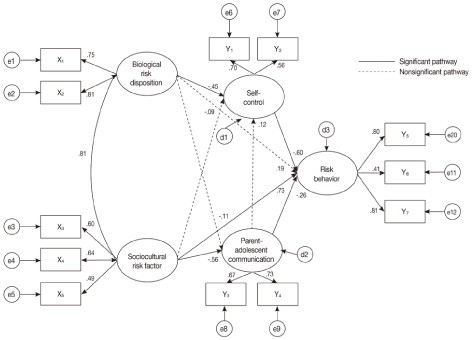
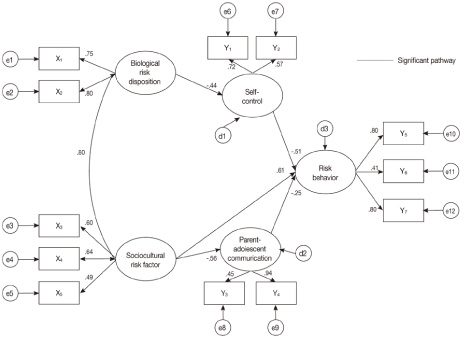
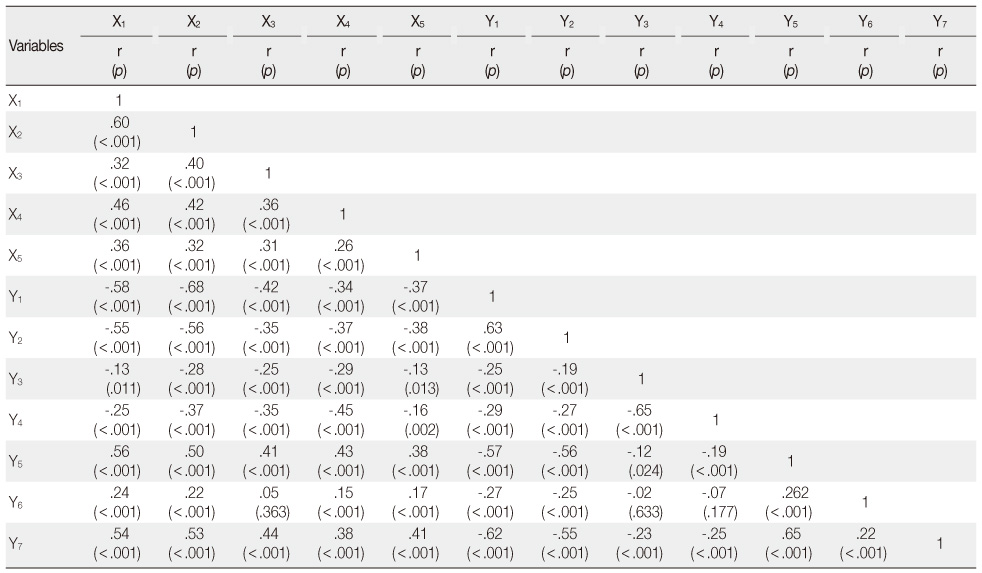
X1=sensation seeking; X2=impulsiveness; X3=parent-adolescence conflict; X4=relationship with risk friends; X5=harmful environments; Y1=long-term control; Y2=short-term control; Y3=father-adolescent communication; Y4=mother-adolescent communication; Y5=rebellious behavior; Y6=antisocial behavior; Y7=thrill-seeking behavior.
Figure & Data
REFERENCES
Citations

- Structural Equation Modeling on Clinical Decision Making Ability of Nurses
Min Kyoung Park, Soukyoung Kim
Journal of Korean Academy of Nursing.2019; 49(5): 601. CrossRef - A Comparative Study on the Factors Influencing Risk Behaviors of Adolescents Living in Small and Medium-sized Cities and Rural Communities
Hyun Sook Park, Hyun Ju Yeo, Sun Young Jung
Journal of the Korean Society of School Health.2016; 29(3): 256. CrossRef - Association of school, family, and mental health characteristics with suicidal ideation among Korean adolescents
Gyu-Young Lee, Yun-Jung Choi
Research in Nursing & Health.2015; 38(4): 301. CrossRef - Teenagers with Smartphones Exposed to Sexual Content
Jeong-Yim Choi, Donghun Chung
The Journal of the Korea Contents Association.2014; 14(4): 445. CrossRef


Figure 1
Figure 2
Descriptive Statistics for Observed Variables (N=387)
Pearson Coefficient Correlations for Measured Variables (N=387)
X1=sensation seeking; X2=impulsiveness; X3=parent-adolescence conflict; X4=relationship with risk friends; X5=harmful environments; Y1=long-term control; Y2=short-term control; Y3=father-adolescent communication; Y4=mother-adolescent communication; Y5=rebellious behavior; Y6=antisocial behavior; Y7=thrill-seeking behavior.
Parameter Estimates for Modified Structural Model and Standardized Direct, Indirect, and Total Effects (N=387)
SP=Standardized parameter; CR=Critical ratio; SMC=Squared multiple co-rrelation.
X1=sensation seeking; X2=impulsiveness; X3=parent-adolescence conflict; X4=relationship with risk friends; X5=harmful environments; Y1=long-term control; Y2=short-term control; Y3=father-adolescent communication; Y4=mother-adolescent communication; Y5=rebellious behavior; Y6=antisocial behavior; Y7=thrill-seeking behavior.
SP=Standardized parameter; CR=Critical ratio; SMC=Squared multiple co-rrelation.
 KSNS
KSNS
 E-SUBMISSION
E-SUBMISSION
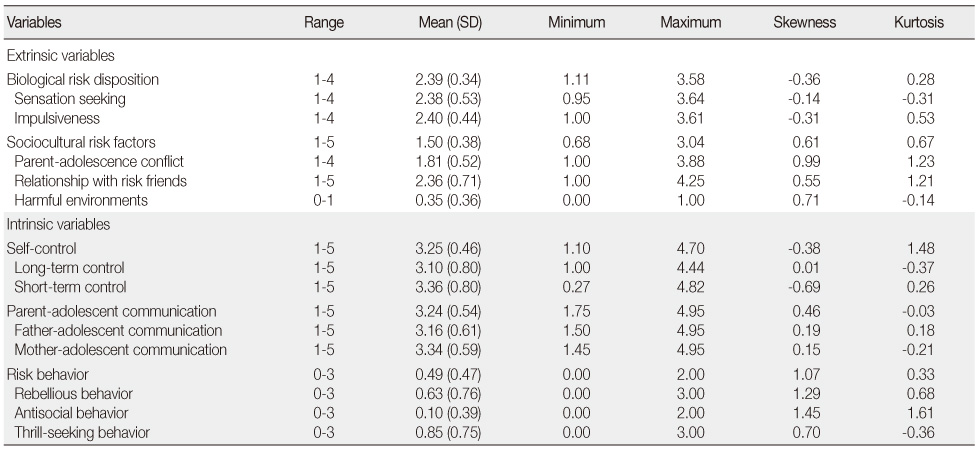
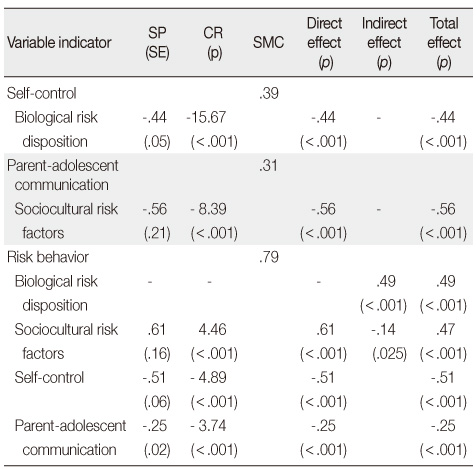
 Cite
Cite

